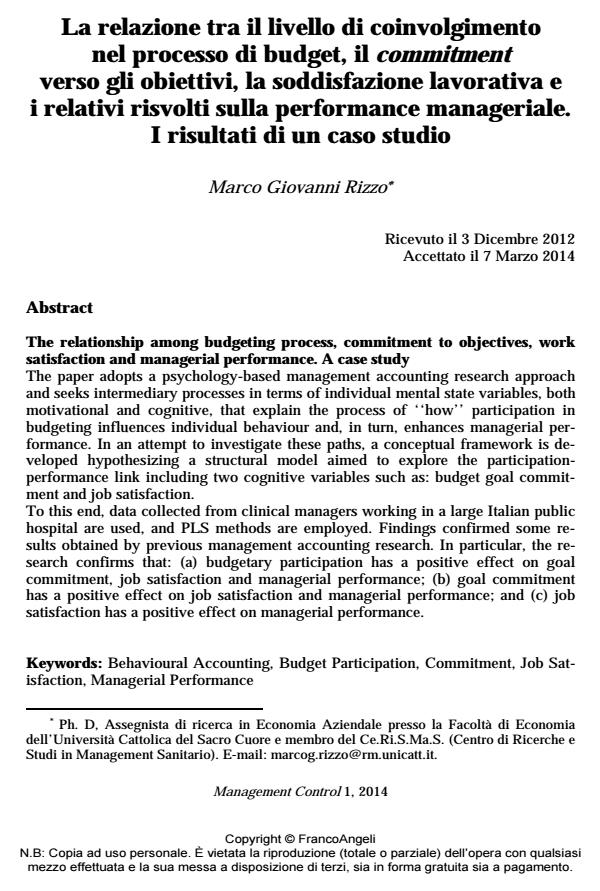La relazione tra il livello di coinvolgimento nel processo di budget, il commitment verso gli obiettivi, la soddisfazione lavorativa e i relativi risvolti sulla performance manageriale. I risultati di un caso studio
Journal title MANAGEMENT CONTROL
Author/s Marco Giovanni Rizzo
Publishing Year 2014 Issue 2014/1
Language Italian Pages 26 P. 9-34 File size 163 KB
DOI 10.3280/MACO2014-001002
DOI is like a bar code for intellectual property: to have more infomation
click here
Below, you can see the article first page
If you want to buy this article in PDF format, you can do it, following the instructions to buy download credits

FrancoAngeli is member of Publishers International Linking Association, Inc (PILA), a not-for-profit association which run the CrossRef service enabling links to and from online scholarly content.
- Soddisfazione lavorativa e work engagement nelle budgeting practices delle aziende sanitarie pubbliche. Una verifica empirica Domenico Raucci, Manuela Paolini, in MANAGEMENT CONTROL 1/2021 pp.13
DOI: 10.3280/MACO2021-001002 - Partecipazione al processo di budget, accuratezza e utilità delle informazioni di budget e performance. I risultati di un caso studi Gianluca D'Agostino, manuela S. Macinati, Marco G. Rizzo, in MECOSAN 92/2015 pp.55
DOI: 10.3280/MESA2014-092004 - Informazioni budgetarie e prospettive di Behavioral Management Accounting nelle aziende sanitarie pubbliche italiane Domenico Raucci, Manuela Paolini, in MANAGEMENT CONTROL 2/2022 pp.117
DOI: 10.3280/MACO2022-002006 - Sustainable Digital Transformation Domenico Raucci, Manuela Paolini, pp.95 (ISBN:978-3-031-15769-1)
- Towards Digital and Sustainable Organisations Manuela Paolini, Domenico Raucci, pp.69 (ISBN:978-3-031-52879-8)
- Orientamento al feedback, soddisfazione rispetto al feedback del sistema reporting e performance di budget Manuela S. Macinati, Marco Giovanni Rizzo, in MANAGEMENT CONTROL 3/2024 pp.179
DOI: 10.3280/MACO2024-003009
Marco Giovanni Rizzo, La relazione tra il livello di coinvolgimento nel processo di budget, il commitment verso gli obiettivi, la soddisfazione lavorativa e i relativi risvolti sulla performance manageriale. I risultati di un caso studio in "MANAGEMENT CONTROL" 1/2014, pp 9-34, DOI: 10.3280/MACO2014-001002